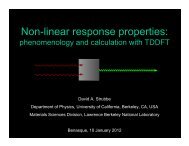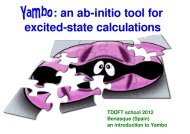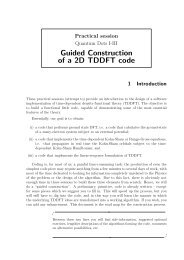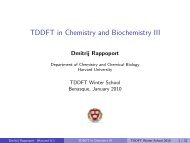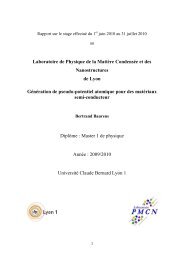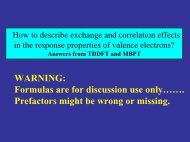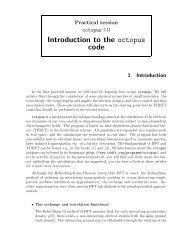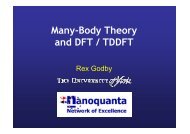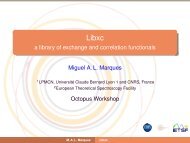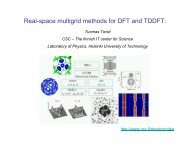Advanced TDDFT II (NM) - TDDFT.org
Advanced TDDFT II (NM) - TDDFT.org
Advanced TDDFT II (NM) - TDDFT.org
You also want an ePaper? Increase the reach of your titles
YUMPU automatically turns print PDFs into web optimized ePapers that Google loves.
<strong>Advanced</strong> <strong>TDDFT</strong><strong>II</strong>. Double Excitations in <strong>TDDFT</strong>f xcNeepa T. MaitraHunter College and the Graduate Center of theCity University of New York
First, quick recall of how we get excitations in<strong>TDDFT</strong>: Linear response(Petersilka, Gossmann & Gross (1996), Casida, (1996))Poles at trueexcitationsPoles at KSexcitationsadiabatic approx: no ω-depNeed (1) ground-state v S,0 [n 0 ](r), and its bare excitations(2) XC kernel~ δ(t-t’)Yields exact spectra in principle; inpractice, approxs needed in (1) and (2).
<strong>TDDFT</strong> linear response in quantum chemistry codes:q =(i a) labels a single excitation of the KS system, with transition frequencyω q = ε a - ε i , andEigenvalues true frequencies of interacting systemEigenvectors oscillator strengthsUseful tool for analysisZoom in on a single KS excitation, q = i aWell-separated single excitations: SMAWhen shift from bare KS small:SPA
Types of ExcitationsNon-interacting systems eg. 4-electron atomEg. single excitationsEg. double excitationsnear-degenerateInteracting systems: generally involve mixtures of (KS) SSD’s that may have1,2,3…electrons in excited orbitals.single-, double-, triple- excitations
Double (Or Multiple) ExcitationsHow do these different types of excitations appear in the <strong>TDDFT</strong> responsefunctions?Consider:χ – polesattruestatesthataremixturesofsingles,doubles,andhigherexcitationsχ S -- poles at single KS excitations only, since one-body operatorconnect Slater determinants differing by more than one orbital.can’t χ has more poles than χ s? How does f xc generate more poles to get states of multiple excitation character?
Simplest Model:Exactly solve one KS single (q) mixing with a nearby double (D)
Invert and insert into Dyson-like eqn for kernel dressed SPA (i.e. ω-dependent):adiabaticstrong nonadiabaticity!This kernel matrix element, by construction, yields the exact true ω’s whenused in the Dressed SPA,
χ -1 = χ s-1- f Hxc
General case: Diagonalize many-body H in KS subspace near the double ex ofinterest, and require reduction to adiabatic <strong>TDDFT</strong> in the limit of weak coupling ofthe single to the double usual adiabatic matrix elementdynamical (non-adiabatic)correctionMaitra, Zhang, Cave,& Burke JCP (2004), Casida JCP (2005)
Simple Model System: 2 el. in 1dVext = x 2 /2Vee = λ δ(x-x’)λ = 0.2Exact: ½ : ½½: ½Exact: 1/3: 2/32/3: 1/3Dressed <strong>TDDFT</strong>in SPA, f xc (ω)
When are states of double-excitation character important?(i) Some molecules eg short-chain polyenesLowest-lying excitations notoriously difficult to calculate due to significant doubleexcitationcharacter.Cave, Zhang, Maitra, Burke, CPL (2004)Mazur, Wlodarczyk, J. Comp. Chem. (2008) – fuller analysis, implementation in Niedoda
When are states of double-excitation character important?(ii) Coupled electron-ion dynamics – propensity for curve-crossing means needaccurate double-excitation description for global PESLevine, Ko, Quenneville, Martinez, Mol. Phys. 104, 1039 (2006)(iii) Certain long-range charge transfer states!Stay tuned for next lecture!(iv) Electron-induced quantum chaos in quantum wellsWasserman, Maitra, Heller, PRA 77, 042503 (2008)(v) Certain autoionizing resonancesNext!
Before doing this, as we are speaking of frequency-dependent kernels, notemore generally some other recent ω-dep kernels developed in the literature(but that don’t capture doubles correctly):-- exact-exchange kernel, A. Görling, (PRA,1998)-- VK kernel of TDCDFT, G. Vignale & W. Kohn (PRL,1996)-- “Nanoquanta kernel”, M. Gatti, V. Olevano, L. Reining, I. Tokatly,arxiv (2008) and citations therein – derived from putting many-bodytheory into <strong>TDDFT</strong>-- See also some talks next week (Casida, Görling)
Autoionizing ResonancesWhen energy of a bound excitation lies in the continuum:KS (or another orbital) pictureωωbound, localized excitationcontinuum excitationTrue system:Electron-interaction mixes these states Fano resonance A<strong>TDDFT</strong> gets these – mixtures of single-ex’s
Auto-ionizing Resonances in <strong>TDDFT</strong>Eg. Acetylene: G. Fronzoni, M. Stener, P. Decleva, Chem. Phys. 298, 141 (2004)But here’s a resonance thatA<strong>TDDFT</strong> misses:Why? It is due to a doubleexcitation.
aiω = 2(ε a ε i )ωbound, localized double excitation withenergy in the continuumsingle excitation to continuumElectron-interaction mixes these states Fano resonance A<strong>TDDFT</strong> does not get these – double-ex
Getting the cross-section in <strong>TDDFT</strong>Photo-absorption cross section:Where ,^^How does the exact kernel addthe resonant bump to χ s ?Need to do a degenerate perturbation theory analysis in the continuum,diagonalizing the bound double-excitation with the continnum states.Aha! Luckily this is closely along the lines of what Fano did in 1961…
Near a Fano resonanceFano’s Universal Resonance Formula^U. Fano, Phys. Rev. 124 , 1866 (1961)^ ^Take T = n(r)where^^^^^Fano line-shapes
ConsiderFano into <strong>TDDFT</strong>to be Kohn Sham statesAdapt Fano analysis:Fornear resonanceIn this 1 st approx, weconsidered coupling betweendouby-excited to continuumonly, and took Γ as thesmallest energy scale in thesystem.
To findwe needUse Kramers-Kronig relation....Assuming
Solooks likeKrueger, Mullady, Maitra (in progress)
Summary (so far) A<strong>TDDFT</strong> fails to describe double-excitations as strong frequencydependenceis needed. Diagonalizing in the (small) subspace where double excitations mixwith singles, we can derive a frequency-dependent kernel that does thejob. Shown to work well for simple model systems, as well as realmolecules (although more testing is needed).Likewise, in autoionization, resonances due to double-excitations aremissed in A<strong>TDDFT</strong>.
An Exercise!• Deduce something about the frequency-dependence required forcapturing states of triple excitation character – say, one triple excitationcoupled to a single excitation.
References:“Double excitations within time-dependent density functional theory linear response”,N.T. Maitra, F. Zhang, R.J. Cave, and K. Burke, J. Chem. Phys. 120, 5932 (2004)“A dressed time-dependent density functional treatment of the $2^1 A_g$ States ofbutadiene and hexatriene”, R.J. Cave, F. Zhang, N.T. Maitra, and K. Burke, Chem.Phys. Lett. 389, 39 (2004)“Exact exchange-correlation kernel for dynamic response properties and excitationenergies in density functional theory”, A. Goerling, Phys. Rev. A 57, 3433 (1998)“Current-dependent exchange-correlation potential for dynamical linear responsetheory”, G. Vignale and W. Kohn, Phys. Rev. Lett. 77, 2037 (1996)“Transforming nonlocality into frequency dependence: a shortcut to spectroscopy”M. Gatti, V.Olevano, L. Reining and I. V. Tokatly, cond-mat.mtrl-sci: arxiv:0705.1887v1“Propagator corrections to adiabatic time-dependent density-functionaltheory linear response theory”, M. E. Casida, J. Chem. Phys. 122, 054111 (2005).“Application of the Dressed Time-Dependent Density Functional Theory for the ExcitedStates of Linear Polyenes”, G. Mazur and R. Wlodarczyk, J. Comp. Chem. in press(2008).“Conical intersections and double excitations in time-dependent density functionaltheory”, B.G. Levine, C. Ko, J. Quenneville and T. J. Martinez, Mol. Phys. 104, 1039(2006)“Valence and core photoionization dynamics of acetylene by TD-DFT continuumapproach”, G. Fronzoni, M. Stener, P.Decleva, Chem. Phys. 298, 141 (2004)“Effect of configuration interaction on intensities and phase shifts”, U. Fano, Phys. Rev.124, 1866 (1961)




